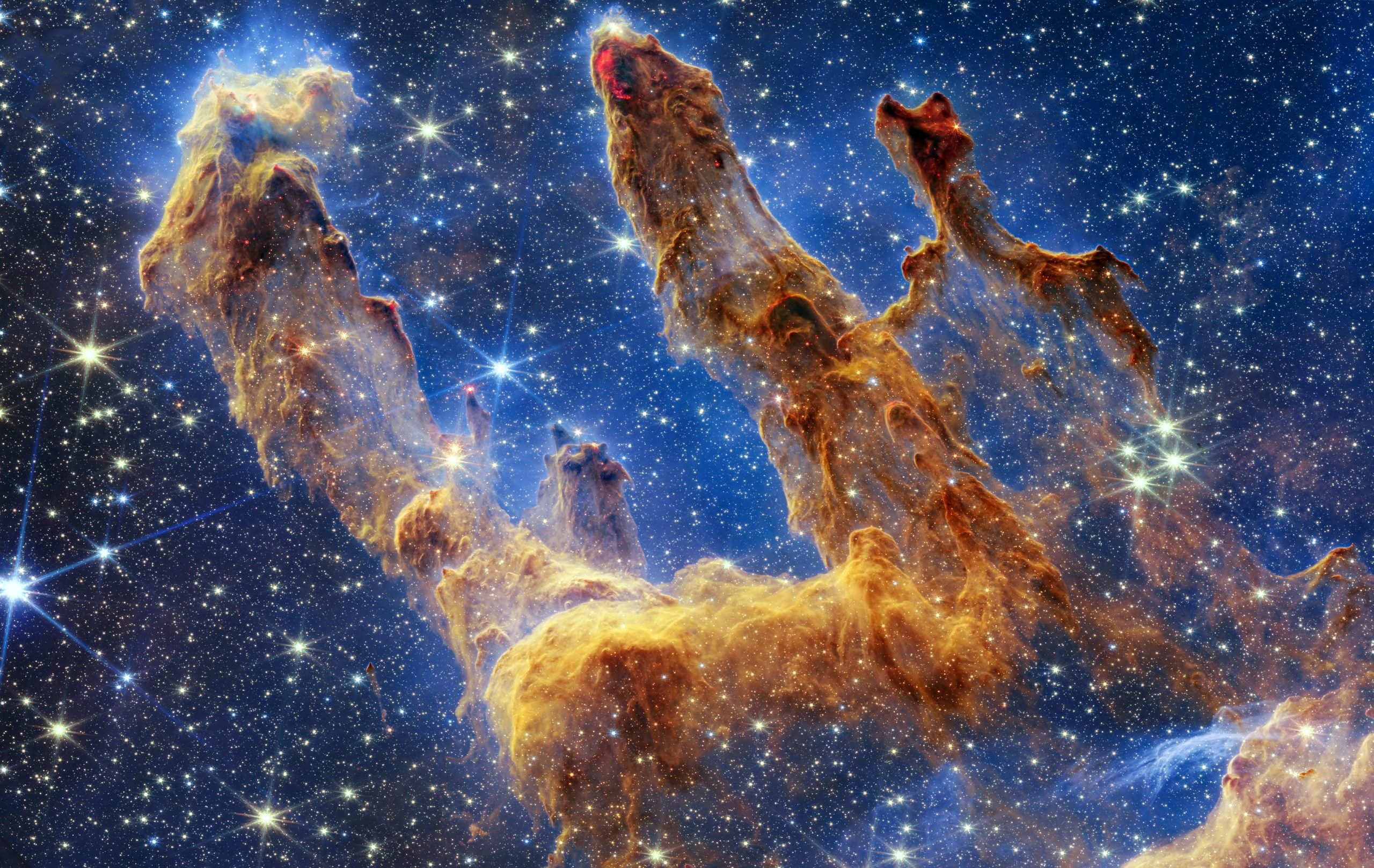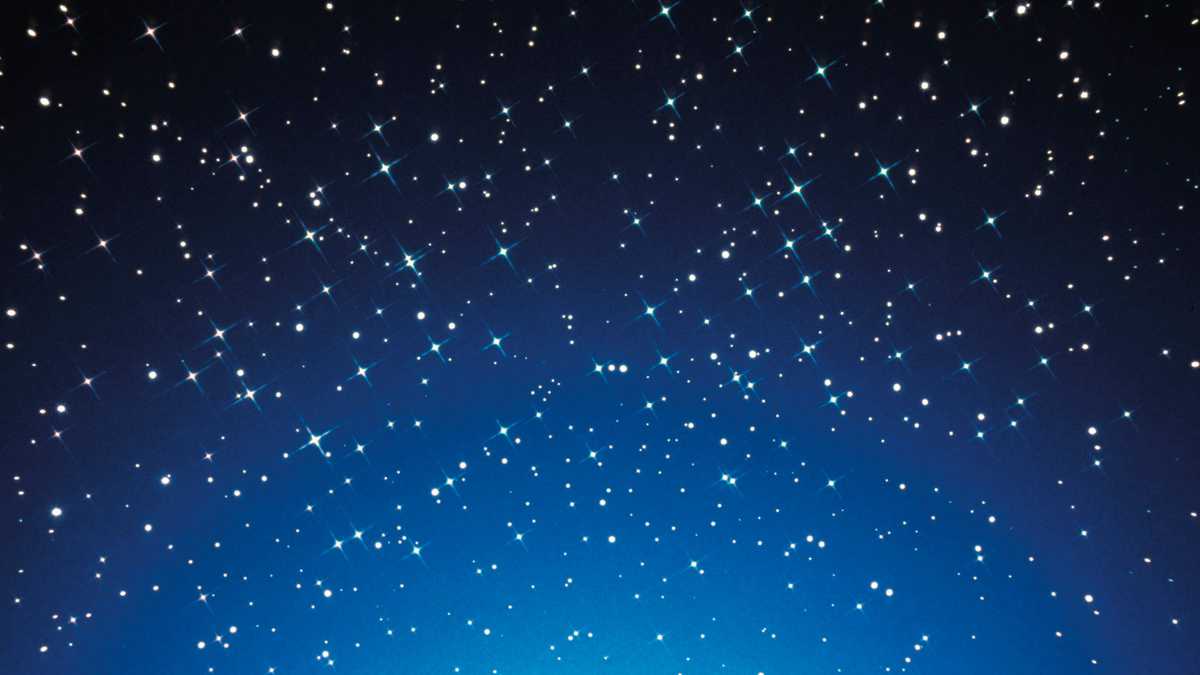
근적외선 빛은 구성 별의 큰 별자리를 드러내며, 그 중 많은 별자리는 여전히 먼지로 둘러싸여 있습니다.
James Webb Space Telescope’s Near-Infrared Camera captured this glittering view of the Pillars of Creation – and it begs to be examined pixel by pixel. It is a stunning scene that may look both familiar and entirely new at the same time. It was first captured by NASA’s Hubble Space Telescope in 1995 and followed up in 2014, and many other telescopes have deeply gazed at this scene. However, this is the first time an observatory has delivered such detailed data in near-infrared light. Newly formed stars pop out in shades of pink, red, and crimson. Still-forming stars that remain hidden deep in dusty pillars resemble molten lava, and fully-formed blue and yellow stars sprinkle the scene.
Where are the galaxies that often “photobomb” Webb’s images? The pillars are located directly in front of our Milky Way galaxy’s disk, which blocks our view of the galaxies that lie behind it. It is also lit up by the collective light from the packed “party” of stars. With these new data, researchers will be able to update complex models of star formation with even more precise star counts and dust quantities. It is clear that we are about to learn a whole lot more about how stars form.

The Pillars of Creation are set off in a kaleidoscope of color in NASA’s James Webb Space Telescope’s near-infrared-light view. The pillars look like arches and spires rising out of a desert landscape, but are filled with semi-transparent gas and dust, and ever-changing. This is a region where young stars are forming – or have barely burst from their dusty cocoons as they continue to form. Credit: NASA, ESA, CSA, STScI; Joseph DePasquale (STScI), Anton M. Koekemoer (STScI), Alyssa Pagan (STScI).
NASA’s Webb Takes Star-Filled Portrait of Pillars of Creation
In exquisite detail, NASA’s James Webb Space Telescope has captured a lush, intricate landscape – the iconic Pillars of Creation. This is a region where new stars are forming within dense clouds of gas and dust. The three-dimensional pillars resemble majestic rock formations, but are far more permeable. These columns are made up of cool interstellar gas and dust that appear – at times – semi-transparent in near-infrared light.
Webb’s new view of the Pillars of Creation, which were first made famous when imaged by NASA’s Hubble Space Telescope in 1995, will help astronomers revamp their models of star formation by identifying far more precise counts of newly formed stars, along with the quantities of gas and dust in the region. Over time, they will begin to build a clearer understanding of how stars form and burst out of these dusty clouds over millions of years.

NASA’s Hubble Space Telescope made the Pillars of Creation famous with its first image in 1995, but revisited the scene in 2014 to reveal a sharper, wider view in visible light, shown above at left. A new, near-infrared-light view from NASA’s James Webb Space Telescope, at right, helps us peer through more of the dust in this star-forming region. The thick, dusty brown pillars are no longer as opaque and many more red stars that are still forming come into view. Credit: NASA, ESA, CSA, STScI; Joseph DePasquale (STScI), Anton M. Koekemoer (STScI), Alyssa Pagan (STScI).
Newly formed stars are the scene-stealers in this stunning image from Webb’s Near-Infrared Camera (NIRCam). These are the bright red orbs that typically have diffraction spikes and lie outside one of the dusty pillars. When knots with sufficient mass form within the pillars of gas and dust, they begin to collapse under their own gravity, slowly heat up, and eventually form new stars.
What about those wavy lines that look like lava at the edges of some pillars? These are ejections from stars that are still forming within the gas and dust. Young stars periodically shoot out supersonic jets that collide with clouds of material, like these thick pillars. This sometimes also results in bow shocks, which can form wavy patterns like a boat does as it moves through water. The crimson glow comes from the energetic hydrogen molecules that result from jets and shocks. This is evident in the second and third pillars from the top – the NIRCam image is practically pulsing with their activity. These young stars are estimated to be only a few hundred thousand years old.
창조의 기둥에 대한 Webb의 근적외선 보기를 비디오로 둘러보세요. 크레딧: NASA, ESA, CSA, STScI; Joseph DePasquale(STScI), Anton M. Coquemore(STScI), Alyssa Pagan(STScI); 다니엘 키르헨블라트(STScI).
근적외선 빛이 웹이 구름을 “통과”하여 기둥 뒤에 있는 우주의 큰 거리를 드러내도록 한 것처럼 보일 수 있지만, 이 견해에는 은하가 없습니다. 그 대신 우리은하 원반의 가장 조밀한 부분에 있는 성간 매질로 알려진 투명한 가스와 먼지의 혼합물이 가장 안쪽 우주에 대한 우리의 시야를 흐리게 합니다. (성간 매질은 은하계의 별들 사이에 분산된 가스와 먼지입니다. 주로 수소 원자, 분자 및 고체 먼지 입자로 구성됩니다.)
이 장면을 처음 촬영한 사람은 1995년 허블 그리고 2014년 개정그러나 많은 다른 천문대에서 이 지역을 깊숙이 들여다보고 있었습니다. 각각의 고급 도구는 조사자들에게 이 지역에 대한 새로운 세부 정보를 제공하며, 실제로 별이 넘쳐납니다.
이 잘린 이미지는 6,500광년 떨어져 있는 거대한 독수리 성운 내부에 촘촘하게 배치되어 있습니다.
그만큼 제임스 웹 우주 망원경 당신은 ~ 역사상 가장 강력한 우주 망원경 그리고 세계 최초의 우주과학 천문대. 그것은 것이다 퍼즐 풀기 우리 태양계에서 저 너머를 보십시오. 다른 별 주위의 먼 세계신비한 구조를 탐험하고 우리 우주의 기원 그리고 우리가 있는 곳. Webb는 나사 파트너와 함께, ESA (유럽 우주국) 및 CSA(캐나다 우주국).

“요은 베이컨과 알코올에 대한 전문 지식을 가진 닌자입니다. 그의 탐험적인 성격은 다양한 경험을 통해 대중 문화에 대한 깊은 애정과 지식을 얻게 해주었습니다. 그는 자랑스러운 탐험가로서, 새로운 문화와 경험을 적극적으로 탐구하며, 대중 문화에 대한 그의 열정은 그의 작품 속에서도 느낄 수 있습니다.”








